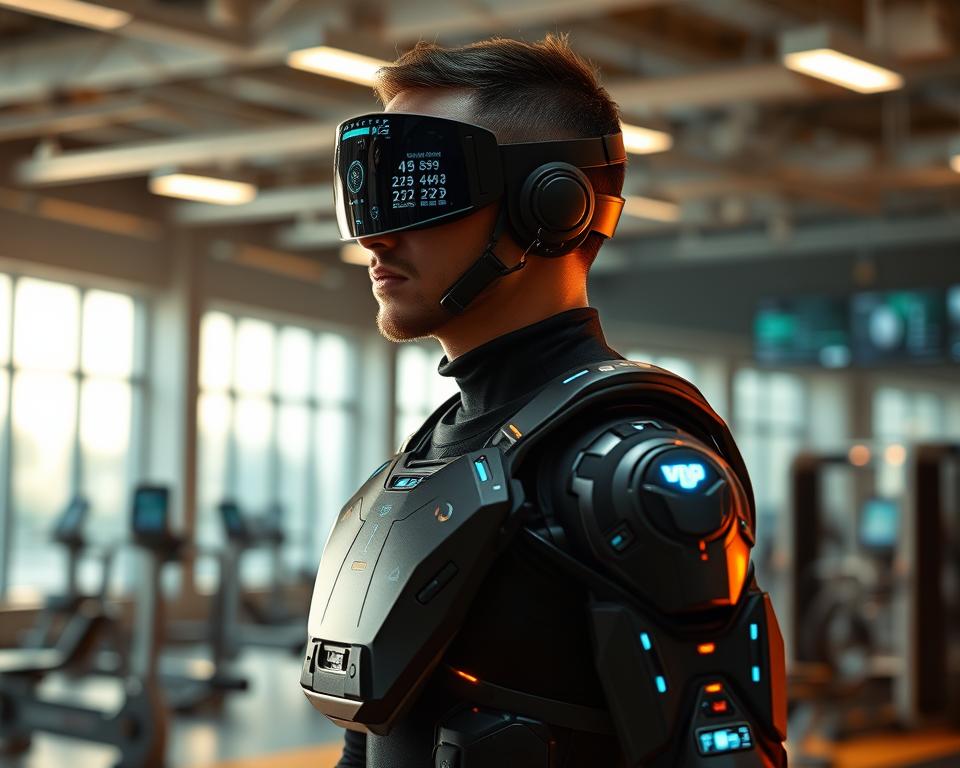Enhancing Performance: The world of sports training is undergoing a significant transformation, driven by technological advancements that are helping athletes optimize their performance like never before.
With the aid of wearable technology, virtual reality, and data analytics, athletes and coaches can now gain valuable insights into training methods, leading to improved outcomes.
These innovations are not only elevating performance but also revolutionizing the way athletes train, making it more efficient and effective.
As we explore the impact of technology on sports training, it becomes clear that the future of athletic development is being shaped by these cutting-edge tools.
Enhancing Performance: The Evolution of Sports Training Technology
The integration of technology in sports training has marked a new era in athletic development. This evolution is not just about adopting new tools but transforming the entire approach to training.
From Stopwatches to Smart Sensors
The journey of sports training technology began with simple devices like stopwatches and has now advanced to sophisticated smart sensors. These sensors can track a wide range of metrics, from heart rate to muscle activity, providing detailed insights into an athlete’s performance.

The Digital Transformation of Athletic Development
Digital transformation has revolutionized athletic development by making it more data-driven. Technologies such as GPS tracking, video analysis, and biomechanical analysis software enable coaches and athletes to improve efficiency and tailor training programs to individual needs.
How Technology Bridges Amateur and Professional Training
Technology has leveled the playing field between amateur and professional athletes by providing access to similar training tools. Amateur athletes can now use apps and wearable devices to boost productivity and achieve a performance enhancement similar to that of professionals.
| Technology | Amateur Use | Professional Use |
|---|---|---|
| Wearable Devices | Tracking heart rate and distance | Advanced biomechanical analysis |
| Video Analysis Software | Basic technique analysis | Detailed performance review |
Wearable Technology: The Athlete’s New Best Friend
The advent of wearable technology marks a significant shift in how athletes approach training, enabling them to maximize their results. Wearable devices provide athletes with real-time data, allowing for immediate adjustments to their training regimens.
Enhancing Performance Tracking Devices and Their Capabilities
Wearable technology encompasses a range of devices designed to track various aspects of an athlete’s performance. These include GPS and heart rate monitors, which provide insights into an athlete’s cardiovascular exertion and spatial movement.
GPS and Heart Rate Monitors
GPS devices track distance, speed, and pacing, while heart rate monitors measure cardiovascular strain. Together, they help athletes increase output by optimizing their exertion levels.
Force Plates and Movement Sensors
Force plates and movement sensors analyze an athlete’s biomechanics, offering insights into jumping ability, sprinting technique, and other movement patterns. This data is crucial for enhancing effectiveness by identifying areas for improvement.
Real-Time Feedback Systems for Immediate Adjustments
One of the key benefits of wearable technology is its ability to provide real-time feedback. This allows athletes to make immediate adjustments to their technique, thereby maximizing results. Real-time data enables coaches and athletes to identify and correct inefficiencies during training sessions.

Case Studies: Professional Athletes Transformed by Wearables
Numerous professional athletes have credited wearable technology with significant improvements in their performance. These case studies highlight the versatility and effectiveness of wearables across different sports.
Team Sports Applications
In team sports, wearable technology is used to monitor player workload, track movements, and analyze team dynamics. This information helps coaches develop strategies to increase output and enhance team performance.
Individual Sport Success Stories
Athletes in individual sports, such as tennis and cycling, use wearables to fine-tune their training. By analyzing data from these devices, athletes can make targeted adjustments to enhance their effectiveness and achieve better results.
Enhancing Performance Through Virtual Reality and Simulation
Athletes are now leveraging virtual reality to optimize their training, pushing the boundaries of performance enhancement. Virtual reality (VR) and simulation technologies are being increasingly utilized in sports training to create immersive and realistic environments that simulate actual competition conditions.
Mental Training in Virtual Environments
VR provides a unique platform for mental training, allowing athletes to practice and perfect their skills in a controlled, stress-free environment. This mental preparation is crucial for enhancing performance under pressure. By simulating various scenarios, athletes can develop the mental toughness required for high-level competitions.
Skill Development Without Physical Strain
One of the significant advantages of VR in sports training is the ability to develop skills without causing physical strain. Athletes can practice their techniques repeatedly without the risk of injury, which is particularly beneficial during recovery periods. For instance, quarterback training systems use VR to simulate game scenarios, allowing quarterbacks to practice decision-making and throwing techniques without physical exertion.
Quarterback Training Systems
Quarterback training systems utilize VR to recreate game situations, enabling quarterbacks to analyze and improve their throws, reads, and decision-making processes in a realistic yet risk-free environment.
Golf Swing Analysis Platforms
Golf swing analysis platforms use VR to provide detailed feedback on a golfer’s swing mechanics, helping them adjust and improve their technique with precision.
Basketball Shooting Mechanics
VR systems for basketball shooting mechanics allow players to practice their shots in a simulated environment, receiving instant feedback on their form and release.
Integrating VR with Physical Training Programs
The true potential of VR in sports training is realized when it is integrated with physical training programs. By combining VR simulations with physical practice, athletes can achieve a more comprehensive training experience. This integrated approach helps in optimizing performance by ensuring that both the mental and physical aspects of an athlete’s training are addressed.
Data Analytics: The Science Behind Athletic Improvement
Athletes are now leveraging data analytics to fine-tune their training, leading to enhanced effectiveness and maximized results. By analyzing various data points, athletes and coaches can gain a deeper understanding of performance capabilities and areas for improvement.
Biomechanical Analysis and Movement Optimization
Biomechanical analysis involves the use of advanced technology to assess an athlete’s movement patterns. This analysis helps in identifying inefficiencies and areas where technique can be improved. By optimizing movement patterns, athletes can improve efficiency and reduce the risk of injury.
Predictive Analytics for Injury Prevention
Predictive analytics uses historical data and statistical algorithms to forecast potential injuries. By identifying risk factors early, athletes and coaches can take proactive measures to prevent injuries, ensuring that training remains consistent and effective.
Personalized Training Programs Through AI
Artificial Intelligence (AI) is revolutionizing sports training by creating personalized training programs tailored to an individual athlete’s needs. AI analyzes data from various sources to recommend the most effective training regimens, helping athletes achieve their goals more efficiently.
Nutrition and Recovery Optimization
Data analytics also plays a crucial role in optimizing nutrition and recovery strategies. By analyzing an athlete’s nutritional intake and recovery patterns, coaches can develop targeted plans that support peak performance and maximize results.
Periodization and Peak Performance Timing
Periodization involves structuring training into specific phases to achieve peak performance at critical times. Data analytics helps in planning and adjusting these phases to ensure that athletes are at their best when it matters most, thereby enhancing effectiveness.
| Aspect | Traditional Method | Data-Driven Approach |
|---|---|---|
| Training Personalization | Generic plans based on coach’s experience | AI-driven personalized plans |
| Injury Prevention | Reactive measures post-injury | Predictive analytics for proactive prevention |
| Nutrition and Recovery | General dietary advice | Data-driven nutrition and recovery optimization |

